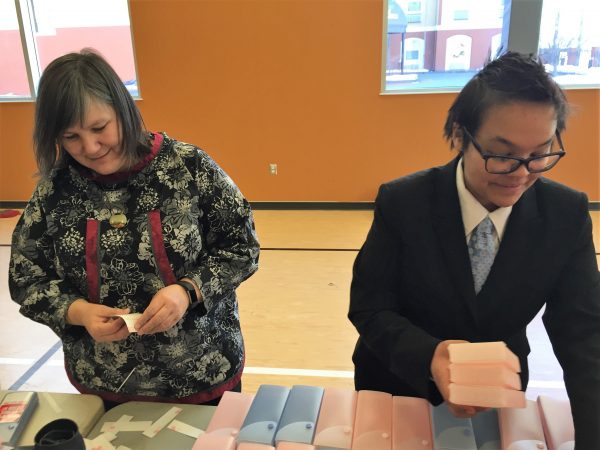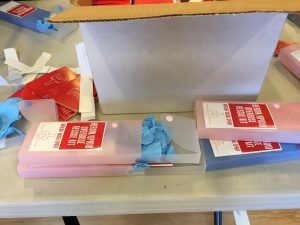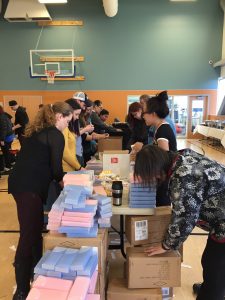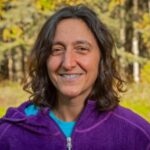
The state’s Department of Health and Social Services is starting to distribute Narcan kits around Alaska. The nasal spray stops opioid overdoses.
Late last month a group at the Covenant House in Anchorage assembled the kits. 20-year-old Nichelle Williams was among them, ripping stickers off plastic pencil cases. Then she carefully lined up each box so the next volunteer could put on a different label.
“They all have to be the same way, so it’s easier to put the stickers on,” William explained patiently. “It makes it easier.”
“She increases our chances not to screw it up!” her fellow volunteer added.
They were at the beginning of a long assembly line for building Narcan kits – small plastic boxes that contain a nasal spray drug, basic instructions, gloves, and CPR masks. The kits will be used to stop overdoses from heroin, OxyContin, and other opioids.
Williams joked about the importance of her role, but she clearly understood the seriousness of what she was doing. Narcan saved her life — twice. Her cousin wasn’t as lucky.

“She ended up dying right in front of me,” Williams recalled. “If I had the Narcan I probably would have been able to save her, but it wasn’t popular at that time.”
That’s why the state is trying to get Narcan into the hands of everyone who might need it. It’s part of the governor’s initiative to fight the opioid epidemic. State epidemiologists report from 2009 to 2015, 774 people in Alaska died from opioid overdoses.
“This isn’t about clinicians. This is about the general public,” Andy Jones said. He’s the chief of emergency response for the state’s Department of Health and Social Services. “What it means is we’re giving a lifesaving tool to everybody who wants one within Alaska. And then they have the capability to be an overdose rescue first responder.”
Administering Narcan to someone who is overdosing will buy time, he said, but you still need to call 911.
“It doesn’t mean it’s a home run for you. It usually means you have about 30 minutes to 40 minutes. Those opioids are still in the body and could bind back to the receptor and throw you back into an overdose,” Jones said.
Jones said some people have the misconception that giving away Narcan will make individuals more likely to use opioids, but that’s not the case. Rapid withdrawal is a painful process. Nichelle Williams has first hand experience with that.
“When I overdosed, and had to get Narcan, that was the worst withdrawal of my life,” Williams said. “I didn’t want to go through that again.”
Having Narcan available did not make her think it was safer to use heroin or encourage her to use. But getting clean wasn’t an easy process and treatment options were not immediately available. Williams started using opioids when she was 17 after being prescribed narcotics for pain from foot surgery, and quickly became dependent. When her pills ran out, she switched to heroin.

“You know, when I experienced getting high, it took all my physical pain away,” Williams said. “And when all my physical pain went away, it went to my head and was like a head and body high for me.”
Williams said it helped ease her emotional pain, and she couldn’t control her cravings. She overdosed three times then was mandated to get treatment. She said the Narcan saved her life, but ultimately she needed a strong support system to stay sober.
“I think that when you go and ask for help, not having people judge you and make you feel like you’re less of a person because you use drugs” helps when trying to get clean,” Williams said.
Williams hasn’t used in six months and plans to start her degree in psychology in the fall.
Young people can request the kits from Covenant House staff to use themselves and give to others. Anyone in the state who needs kits can email projecthope@alaska.gov.
Anne Hillman is the healthy communities editor at Alaska Public Media and a host of Hometown, Alaska. Reach her at ahillman@alaskapublic.org. Read more about Anne here.





